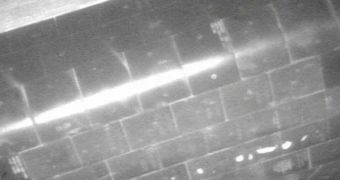The seven astronauts aboard the space shuttle Atlantis have concluded that their spacecraft has suffered only minor damages from debris that hit it during lift-off. Images and readings collected with the sensor pole showed only minor dings alongside a few of the tiles making up its heat shield, and NASA engineers have reasoned, at this point, that they do not pose a threat to the integrity of the orbiter. However, the experts say, they will continue to analyze the dents and to run simulations of Atlantis' reentry, until the craft itself returns to Earth, on May 22nd.
The damaged area, reports say, is about 21 inches (53 centimeters) in length, and spans about four of the craft's thermal tiles, located on its starboard side. A NASA press release pinpoints that the damages have occurred in the area where the wing blends in with the front fuselage, a region where this type of dents appears with a greater frequency than in other parts of the ship. Preliminary reports and images that engineers have received show that the indentations are not deep and that the structure of the craft is not exposed underneath the damaged tiles.
“Everybody is feeling pretty good that it's not something particularly serious. We just want to make sure we do the right thing and complete all the analysis,” Space quotes Atlantis Astronaut Daniel Burbank as saying. “They looked very minor, but we're going to let the folks go ahead and take a look at it, follow the standard process and determine what to do next on it,” the Lead Shuttle Flight Director, Tony Ceccacci, told reporters in a recent press conference, held at the Johnson Space Center. Most likely, the debris that caused the damage fell from the shuttle's external tank, when the vehicle blasted to orbit Monday afternoon.
Astronauts and mission controllers are also considering the possibility of having a second look at the heat shield, which would bring the total number of inspections to three, as opposed to the average two. Regularly, astronauts just carry out two heat shield surveys, one when they reach orbit, and one just before returning to Earth and starting the atmospheric reentry process.
In addition to the minor dents on the shuttle, NASA has also recorded some damage to the launch pad used for the take-off. According to NASA spokesperson Allard Beutel, Kennedy Space Center's Launch Pad 39A received some unexpected damage from the lift-off, in that the blast from the delivery system's engines affected a number of nitrogen lines running nearby. In addition, some 25 square feet of flame-retardant material, located in an exhaust trench at the launch pad, were also damaged by the power of the take-off. NASA tells that it expects the damage to be dealt with in time for the next scheduled shuttle mission, on June 13th.

 14 DAY TRIAL //
14 DAY TRIAL //